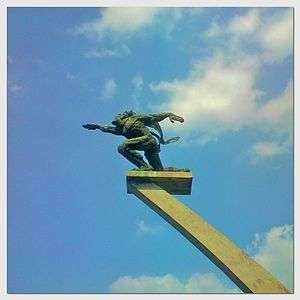Dirgantara Monument
| Dirgantara Monument | |
|---|---|
|
Native name Indonesian: Monumen Patung Dirgantara | |
 | |
| Location | Pancoran, Jakarta, Indonesia |
| Coordinates | 6°14′35″S 106°50′36″E / 6.243085°S 106.843472°ECoordinates: 6°14′35″S 106°50′36″E / 6.243085°S 106.843472°E |
| Built | 1966 |
| Sculptor | Edhi Sunarso |
Dirgantara Monument (Indonesian Monumen Patung Dirgantara), also known as Gatot Kaca Monument after the Javanese wayang figure, is a monument located in Jakarta, Indonesia. It is also known Tugu Pancoran, tugu a word for statue and pedestal, and being located in South Jakarta's subdistrict of Pancoran. The monument was commissioned by President Sukarno in 1964 as a tribute to the Indonesian Air Force and early Indonesian aviators who flew against the Dutch to help achieve independence.[1]
Description
Dirgantara Monument is situated on the junction of Jalan Gatot Subroto and Jalan M.T. Haryono and looks along Jalan Dr. Supomo into the suburb of Tebet.[1] Tebet suburb itself was developed from the early 1960s to house people displaced by the construction of the Gelora Bung Karno sports complex at Senayan.
The monument soars on top of a 27 meters high arched socle.[2] The statue on top of the socle is an 11-meter bronze sculpture of a man, weighing 11 tons.[3] The statue depicts the manusia angkasa, "space man", symbolizes the conquest of space by the nation.
History
The idea for the construction of the monument came from President Soekarno who wanted a statue as a homage to Indonesian airways, and to the conquest of space.[4] The chosen location is in front of the headquarter of the Indonesian Air Force designed by Silaban (demolished, now the office complex Wisma Aldiron Dirgantara).[3] The location chosen was strategic because it is also the gateway to Jakarta for visitors coming from Halim Perdanakusuma Airport.
The statue was designed by Edhi Sunarso around 1964 - 1965 with the help of the Arca Family of Yogyakarta. While the casting process is carried out by the Decorative Bronze Art Bronze Sculpture of Yogyakarta led by I Gardono. The development process is done by PN Hutama Karya with Ir. Sutami as the executing architect.[3] Sukarno partly funded the construction of this monument after he sold his private car.[3]
Unlike many monuments of the 1960s; the construction of the Dirgantara Monument took a long time to complete due to the September 30th Movement of the PKI in 1965 and their aftermath.[4] During the delay, the monument was left without its bronze sculpture for more than a year. Rumors spread that the monument depicts an eye extractor said to be used by the PKI during the torture of the generals, although this has been repeatedly bashed by President Sukarno.[3] The bronze sculpture was assembled section by section (each section of the bronze sculpture weighted about 1 ton) until it was finally completed at the end of 1966, completing the Dirgantara Monument.[3]
During the late 90s two elevated toll roads were constructed, flanking the monument in front and at the back.[1]
Popular culture
Several notable nicknames for the Dirgantara Monument are "Truper" (a corruption of "trooper"), as some people think the statue depicts a parachutist, the rags of clothes is taken as remnants of a parachute. The arch which is shaped like number seven, contributes to it being nicknamed the "Seven-up Man". The Dutch in Jakarta called it "Ard Schenk", because the posture of the arms are reminiscent of a skater.[2]
See also
| Wikimedia Commons has media related to Dirgantara Monument. |
Other statues constructed by Edhi Sunarso in the 1960s:
References
Cited works
- Dinas Museum & Sejarah (1982). Sejarah singkat patung-patung dan monument di Jakarta [Short history of statues and monuments in Jakarta] (in Indonesian). Jakarta: Pemerintah Daerah Khusus Ibu-Kota Jakarta.
- Lecrec, Jacques (1993). "3. Mirrors and the lighthouse: A search for meaning in the monuments and great works of Sukarno's Jakarta, 1960-1966". In Nas, Peter J.M. Urban Symbolism. BRILL. ISBN 9789004098558.
- Merrillees, Scott (2015). Jakarta: Portraits of a Capital 1950-1980. Jakarta: Equinox Publishing. ISBN 9786028397308.
- Nas, Peter J.M. (1993). "1. Jakarta, city full of symbols: An essay in symbolic ecology". In Nas, Peter J.M. Urban Symbolism. BRILL. ISBN 9789004098558.